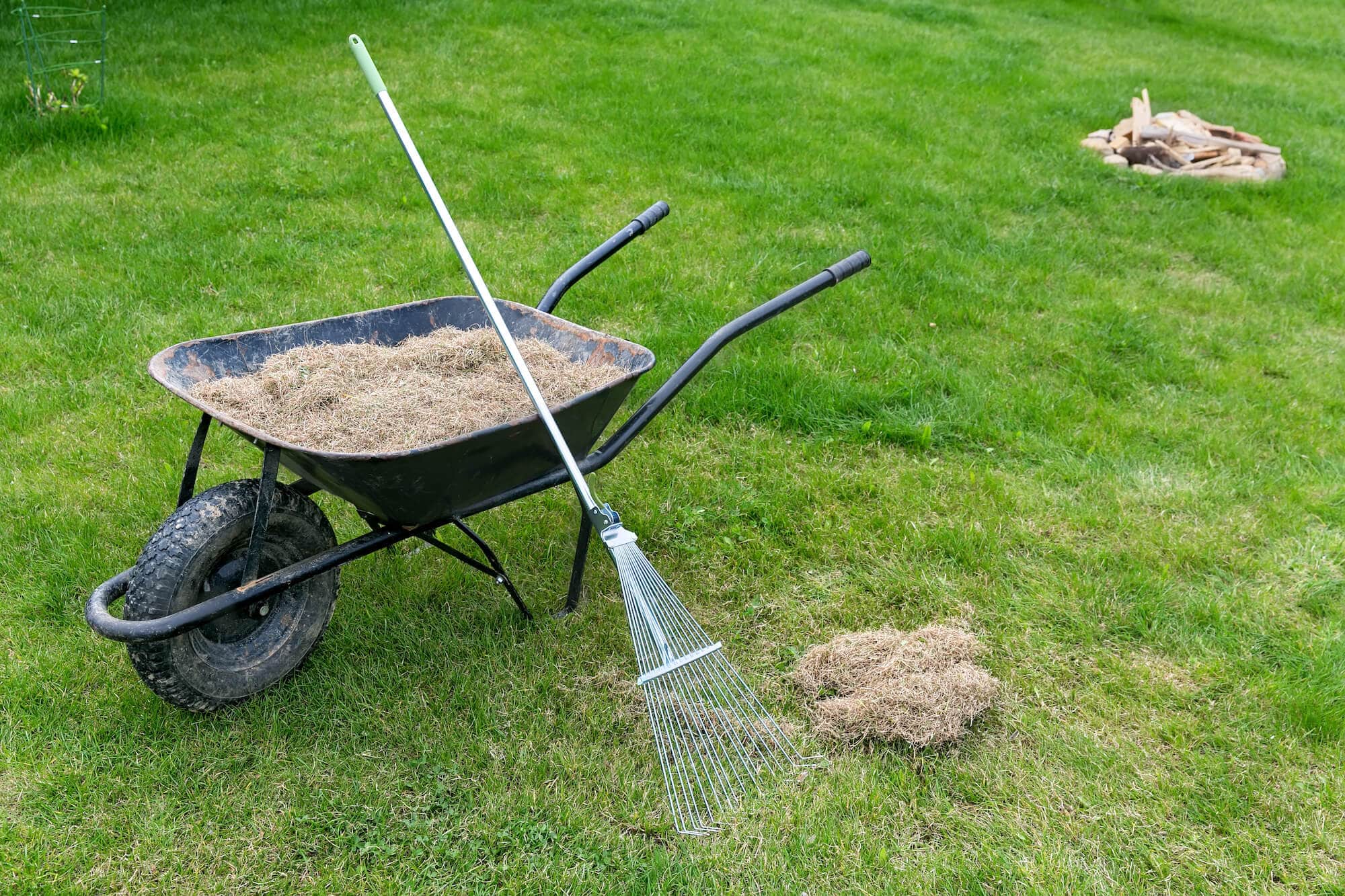How to Dethatch Your Lawn: a Step-by-Step Guide
Your lawn’s turf is a growing, dynamic ecosystem, and maintaining it can take a bit of skill. If you were to cut out a thin cross-section of your lawn, you’d spot three distinct layers—the roots and soil, the thatch layer, and the grass leaves.
Thatch is a naturally occurring collection of dead and living organic material that plays a part in protecting your turf’s long-term health. In most instances, you’ll never need to think about your thatch because it simply self-regulates. However, poor turf management can cause the thatch to grow too large, cutting out important nutrients, water, and light to your grassroots.
When this occurs, you could end up with a whole range of trouble on your lawn. Take these steps to diagnose overgrown thatch and dethatch your turf with the knowledge of a professional.

What is Thatch?
Despite the constant focus on getting rid of thatch in your lawn, it is actually very helpful when maintained at the right levels. Without thatch, there would be no barrier between the grass leaves and roots to regulate temperature, moisture, and airflow.
Thatch forms from a mixture of:
- Dead plant materials like the clippings from your grass
- Roots
- Rhizomes
- Stolons
The ideal size of your thatch layer is one half of an inch or smaller. Thatch tends to grow for a large variety of reasons, including:
- Overuse of pesticides or weed killers
- Too much nitrogen from fertilizer
- Incorrect mixture of grasses for your region
- Excessive moisture
- Overly dense grass layer
- Imbalanced pH in your soil
What is Dethatching?
Dethatching is the act of breaking up this thick layer without removing or damaging the grass itself. Special handheld and powered tools cut into the earth to pull up the thatch layer, allowing water and moisture to permeate the roots. After dethatching and making proper changes that lead to the thatch overgrowth, the layer should begin to self-regulate properly once more.
Dethatching typically requires several tools, including:
- Dethatching rake
- Vertical mower
- Special attachment to your mower
Dethatching is a bit like the process of aeration—a task that removes small cores of soil, roots, thatch, and grass to welcome air and water back into the deeper layers of the earth.
While both processes can make your lawn look initially much messier, the long-term result encourages your lawn to grow back far stronger and thicker.
Why Is Dethatching Important?
When thatch forms, it should act as a permeable barrier between the outside elements and the grassroots. When it becomes too thick, you end up with a whole list of problems, including dead patches throughout your lawn.
For one, overgrown thatch throws off your balance of moisture in your lawn. Too much water can attract pests, encourage mold growth, and lead to erosion.
Dethatching is also critical for annual maintenance steps for your lawn, such as fertilization and overseeding. By opening up the earth to the nutrients it needs, it is easier to get ahead of larger issues by accessing and remedying the soil.
Dethatching Tools: What You’ll Need
Like most lawn care tasks, there are both simple and more complex ways to go about dethatching your lawn. If you have a small property—or are just detaching a small area—many of the manual tools below will work just fine. Power dethatchers, however, are always best for large lawns, especially if you want to save yourself some time and energy.
Lawns in need of a serious dethatching require professional care. Your local TruGreen team will have the tools and experience to remove thick thatch without damaging your existing turf.
If you’re planning to tackle the project yourself, here are some important tools for the task.
Thatching Rake (Cavex Rake)
For simpler jobs or for a quick pass at the beginning of the season, a thatching rake will do the job just fine. The tool looks a lot like a traditional rake, but its teeth are much sharper and shaped to cut into the ground and pull up the thatch beneath your grass.
Power Rake
Similar to a mower, these automatic dethatchers allow you to simply guide the machine as blades tear up the thatch in even rows. Power rake dethatchers, however, can cause damage to your lawn when used too often, especially if your thatch is not very thick. Use this process sparingly or on a studier grass variety.
If you plan to dethatch your lawn on a regular basis, you can purchase a dethatcher for anywhere from several hundred dollars to upwards of $2,000. However, since this is commonly a once-a-year process, renting a motorized dethatcher may be your best bet.
Dethatching Attachment or Vertical Mower
If you have a versatile walk-behind or tractor mower, you can also purchase a dethatching attachment to get the job done. This is a cost-efficient solution if you plan to dethatch once a year and already have a mower that can do the job. Attachments range in teeth size and design elements for each maneuvering.
Vertical mowers are ideal for extreme thatch can tend to cut deep into the earth, reaching down to the roots when necessary. Only use vertical mowers during a high growing season when you know your turf is ready to heal quickly.
Handheld Aerator or Small Shovel
Use one of these two small tools to remove a core of grass from your lawn before dethatching. This will allow you to look at a subsection of your lawn to measure the thatch itself.
The Best Time to Dethatch a Lawn
Dethatching should always coincide with the primary growing season for your type of grass. While the process shouldn’t harm your turf, it is best to perform tasks when your grass can quickly rejuvenate itself.
If you live in the northern parts of the country, you’ll like to have a lawn of cool-season grasses. Check your lawn for thatch overgrowth and plan to dethatch at the end of the summer or beginning of fall. This is when cool-season grasses flourish, meaning that they can stand strong against a little stress.
Warm-season grasses are best when dethatched in mid-to-late spring. With the warmest time of year right around the corner, these grasses will be ready to flourish after the thatch has been removed.
How to Dethatch Your Lawn
Let’s say that you’ve tested a core of your lawn and your thatch measures far above the half-an-inch limit. You’ve made it to the ideal time of year to dethatch your type of grass and you’re ready to go. Here is a step-by-step guide for dethatching your lawn.
- Ensure that your soil is moist but not saturated with water. Too much moisture will cause the soil to break up too quickly while digging into dry soil can harm your turf. Water the afternoon before for best results.
- Lower the blades on your mower as you would in the fall, cutting your grass to about an inch below what you normally would in the high season.
- If you’re using a dethatching rake, pull the rake toward you, breaking up the brown layer just below the grass leaves. It should begin to come up in piles on your lawn.
- If you’re using a power rake or vertical mower, check your lawn for sprinkler system pipes or any other underground items and mark for safety.
- Adjust the height of the blades depending on your layer of thatch. Walk the mower in even lines back and forth across your lawn, being careful not to hit the same area twice.
- Remove the loosened thatch from your lawn with a traditional rake.
- Water your lawn soon after dethatching to encourage growth and consider a layer of fertilizer if there was significant damage.
How to Stop Thatch Overgrowth
As we mentioned above, thatch doesn’t usually grow out of control on its own. Poor lawn management or severe climate issues often prevent the thatch from breaking down, leading to a damaging layer that can hurt your lawn over time.
We’ve included some of the top ways to adjust your lawn care schedule to prevent too much thatch from forming.
Go Easy on the Fertilizer
Nitrogen aids in the necessary growth of your roots and grass leaves, but too much of it can also cause thatch to grow too quickly. As your grass breaks down, it adds to the thatch layer, growing it faster than it can deteriorate.
If you’re concerned about thatch, choose a fertilizer with a lower nitrogen percentage or only fertilize when absolutely necessary.
Overseed With Low-Thatch Grasses
Some grasses—such as common options like Kentucky bluegrass—are extra prone to developing thick thatch. Mix these varieties with complementary grasses when you overseed to help cut down on the thatch later.
Skip the Chemicals if You Can
Certain pesticides, herbicides, and fungicides can encourage the overgrowth of the organisms in your thatch as well as the root systems that break down into it. An occasional treatment shouldn’t affect your thatch, but constant use can lead to issues.
Check Your Soil pH
Your thatch needs a collection of microorganisms to break down the thatch naturally. If your soil becomes too acidic, it can no longer support these organisms, causing your thatch to take off. Measure your soil pH with an at-home test or speak with your local landscape professional.
Aerate Your Lawn Regularly
Aeration is a great alternative to dethatching if it has yet to grow out of control. While the process is similar, aerators remove cores or slices of soil, roots, thatch, and grass leaves all at once. Breaking up your soil once a year allows air, moisture, and nutrients to reach the base of your roots.
Aerating your lawn is also ideal before you plan to fertilize or overseed your lawn. An annual aeration can protect you from having the dethatch in the first place.
TruGreen’s Dethatching Process
Dethatching your lawn is one of those tricker processes in the lawn care schedule, and is often best left to the professionals.
When you sign on for one of TruGreen’s comprehensive lawn care packages, your team will monitor your lawn’s heath, diagnose issues like overgrown thatch, and complete the process without delay.
TruGreen can also determine why the thatch grew too large in the first place and remedy your lawn care regimen for a healthier turf. With services like targeted weed control, slow-release fertilizer treatments, and regular aeration, you can avoid the timely task of detaching.
Speak with your local TruGreen team today for a personalized quote and plan to care for your lawn year-round.







